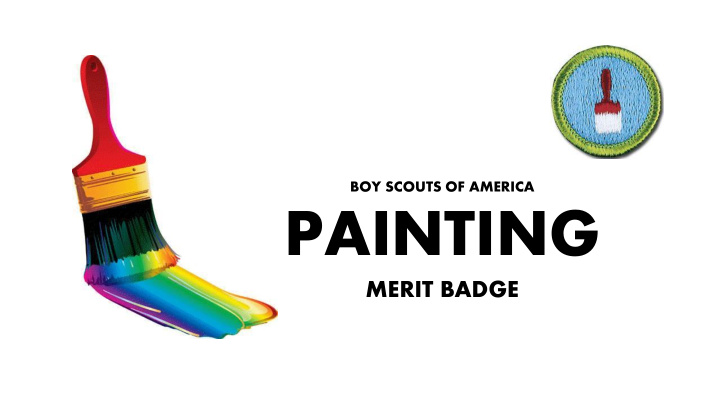



BOY SCOUTS OF AMERICA PAINTING MERIT BADGE
Explain the proper safety procedures when preparing surfaces and applying coatings. • Follow manufacturer’s instructions and warnings ! • Use the right product for the job. • Work in a well ventilated area. • Restrict traffic in your work area. • Protect eyes from drips & splashes. • Protect skin with gloves & clothing. • If using flammable materials, have a fire extinguisher on hand. • Know what the previous coating was. Avoid lead exposure.
Be alert for the presence of lead-based paint. 1978
SURFACE PREPARATION • Surface preparation is one of the most important parts of the job. • The purpose is to create a clean, dry, sound surface to which the paint can properly adhere. • Consider these factors: • type and condition of surface • location and environment • coating to be used • manufacturer’s recommendations
SURFACE PREPARATION • Walls: free of dirt, grime, oil, grease, and chipped paint Patch any holes. Sand lightly in a circular pattern. • Wood: dry, clean, sanded, and dust-free Sand in the direction of the grain. Apply a primer to new or bare wood. • Concrete: free of dirt, oil, and grease Sweep, wire brush, and vacuum as needed. Patch any holes. • Metal: clean, smooth, rust-free, and dry Use a wire brush and sandpaper as needed.
SURFACE PREPARATION INDOORS • Repair holes with patching compound or spackle. • Sand lightly when dry. • Caulk to fill cracks, seal joints, or bridge gaps. • Mask with painter’s tape and plastic sheeting. • After painting, slowly remove tape by pulling at a 90 -degree angle.
PRIMERS Primers are used to seal porous surfaces or to help paint adhere. • Wood: oil-based or water-based for indoor or outdoor uses • Drywall: sometimes needed when old paint is dark or textured • Steel: oil-based for rough or poorly cleaned surfaces • Concrete: usually highly alkaline
Explain how coatings can improve a surface. • Pleasing appearance • Durability • Environmental resistance
Explain the difference between oil-based paints, acrylic-based paints, and water-based paints. OIL-BASED PAINTS • Oil-based paints contain a drying oil, oil varnish, or oil-modified resin as a binder. • They dry slower than water-based paints and have a strong odor • The final paint film – the topcoat – is formed by oxidation, a chemical process by which oxygen combines with the oil and hardens the paint.
Explain the difference between oil-based paints and water-based paints. WATER-BASED PAINTS • Water-based paints contain no oil, so they dry quicker and have less odor. • The final paint film is formed when the water evaporates. • Water-based paints include latex and acrylic.
USES OF PAINTS ACRYLIC • Acrylic paints are water-based. • They are excellent for durability and color retention. • They are easy to apply, and easy to clean up with soap and water. • Acrylics are appropriate for interior and exterior surfaces. • They are popular for craft uses as well.
USES OF PAINTS ALKYD • Alkyds are synthetic resins used in paints and other coatings. • Alkyd paint is oil-based and its drying time depends on the type of oil used. • They have high durability for withstanding weather, and are often used on the exterior of homes and businesses.
USES OF PAINTS POLYURETHANE • Polyurethane is a resin used in paints where durability and adherence are needed. • Some polyurethanes are mixed with acrylics to get the desired durability, color retention, and resistance to abrasion.
USES OF PAINTS LATEX • Latex paint is made of water-based pigments, synthetic polymers like vinyl acrylics, and other chemicals. • Cleanup is easy with soap and water. • Latex is not as durable as oil-based paints. • Price varies widely with how much latex vs. filler the paint contains.
USES OF PAINTS VARNISH • Polyurethane varnish is best used on everyday furniture that gets a lot of wear. Drying time is fast. • Oil-based varnish is made with alkyd or phenolic resin. These varnishes yellow faster. They’re used where resistance to weather is important like exterior doors and boat decks. • Acrylic varnish is water- based and doesn’t penetrate wood as deeply as oil-based varnish. As a result, it is not as hard or moisture- resistant.
Explain the importance of sheen. • Sheen refers to the degree of shine or gloss in a coating. • The sheen you choose will depend on what you are painting. • High gloss coatings contain more resin and have more resistance to weather and wear. Most exterior trims are made to a gloss or semi-gloss finish. • Interior coatings use less resistant resins, and often contain more pigment. They are available in a variety of sheens from flat to glossy.
SHEEN • Flat – is typically used for ceilings and some interior walls. • Eggshell – has a slight sheen and is popular for interior walls. • Semi-gloss – is often used for trim, doors, and windows. It’s also often used in kitchens and bathrooms because it is more washable and water resistant.
CAREERS
YOUR PROJECTS • What will you paint? • What type of paint will you use? • How much paint will you need? • What tools will you use? • How will you prepare the surface and surrounding area?
YOUR PROJECTS • What application method will you use?
YOUR PROJECTS • Will you need to climb?
YOUR PROJECTS • How will you clean up?
YOUR PROJECTS Harmonizing colors: • Select a main color. • Use lesser, unequal amounts of secondary or accent colors.
YOUR PROJECTS • How will you safely store the materials?
Recommend
More recommend